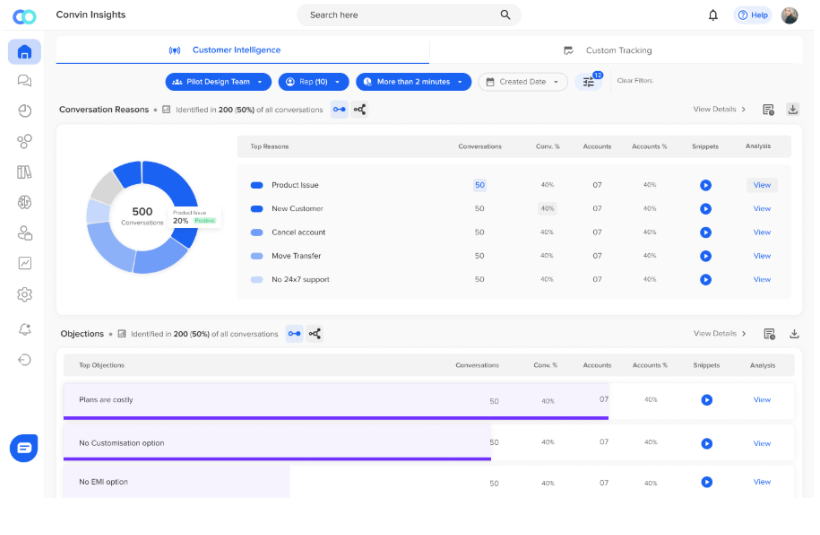Insurance sales have reached a breaking point where adding more reps no longer guarantees more conversions.
Rising acquisition costs and shifting customer expectations are tightening margins across the industry. A study by J.D. Power found that 42% of insurance customers now expect immediate responses during the sales process.
At the same time, the cost of expanding sales teams keeps rising. Training alone accounts for nearly 20% of annual rep spend in many insurance organizations, according to LIMRA. Leaders aren’t just trying to hit revenue targets, they’re trying to hit them efficiently, without bloated teams or inconsistent performance. This is where the traditional “hire more reps” playbook starts to crack.
In this blog, you’ll see why headcount-heavy models fall short, what’s driving the shift toward automation, and how tools like real-time assist, call intelligence, and automated workflows help teams improve conversions without expanding payroll.
If you’ve been questioning whether more people is truly the answer, the insights below will give you a clearer path forward.
Insurance leaders often default to expanding teams when conversions stall, but data shows the approach rarely pays off at scale. The cost, complexity, and inconsistency of human‑only operations make headcount one of the least efficient levers for growth.
Adding reps creates more overhead than outcomes. Between hiring, onboarding, training, and churn, the costs quickly spiral.
Cut the noise, see what truly drives insurance conversions today.
Why “Just Hire More Reps” Fails in Insurance Sales
Hiring more reps feels like the fastest path to boosting conversions, but insurance operations rarely benefit from brute-force scaling. With people-dependent workflows, performance varies widely, costs rise quickly, and operational cracks widen with every new hire.
Insurance leaders often default to expanding teams when conversions stall, but data shows the approach rarely pays off at scale. The cost, complexity, and inconsistency of human‑only operations make headcount one of the least efficient levers for growth.
Adding reps creates more overhead than outcomes. Between hiring, onboarding, training, and churn, the costs quickly spiral.
1. Operational gaps that hiring alone can't fix:
Hiring more reps may seem like the fastest path to increased coverage, but structural bottlenecks remain. Ramp-up time is a major drag on productivity.
Industry research by AA-ISP shows that new reps take an average of 4.8 months to reach full competency, stretching timelines and slowing conversion momentum. Convin’s internal data echoes this, revealing that unassisted agents experience early-stage performance dips due to inconsistent coaching.
Attrition compounds the issue. According to the U.S. Bureau of Labor Statistics, insurance sales roles see annual turnover rates exceeding 30%. Every departure restarts the hiring cycle, costing time, attention, and revenue opportunities. This churn erodes continuity, forcing leaders to repeatedly rebuild capability instead of compounding it.
Messaging inconsistency further widens performance gaps. When reps improvise scripts or deviate from positioning, conversion quality weakens. Research from RAIN Group shows that inconsistent messaging can reduce overall close rates by up to 18% .
Headcount expands capacity, but without automation and intelligence, the operational cracks stay exactly where they are.
Stop patching gaps, strengthen performance with smarter systems.
Rise of the AI Insurance Sales Agent in Modern Workflows
Insurance buyers expect speed, accuracy, and personalization in every conversation. That’s where traditional models fall short. AI-driven systems step in to close these execution gaps, improving conversion velocity and reducing friction.
Manual methods struggle to deliver speed and personalization at scale. In contrast, AI-driven tools offer both, plus consistency. According to McKinsey, companies using AI in sales report up to a 50% increase in leads and appointments. For insurance leaders, this isn’t just tech, it’s transformation.
1. What an AI insurance sales agent brings to the table:
AI insurance sales agents fill the speed and consistency gaps that human teams naturally struggle with. They respond instantly, handle large lead volumes without fatigue, and maintain uniform quality across every interaction.
According to Accenture, 75% of insurance consumers prefer brands that offer real-time support and fast resolution. AI bridges that expectation gap by delivering immediacy at scale.
Instant lead engagement changes conversion math. Harvard Business Review found that contacting leads within 5 minutes makes teams 9x more likely to convert. AI agents ensure no lead waits, no call queues build, and no opportunities age out. This means higher pipeline velocity without heavier staffing.
This isn't about replacing human reps. It's about augmenting them with smarter, faster tools. Convin, for example, integrates real-time agent assist and conversation intelligence directly into existing workflows, no major system overhaul required.
Equip your team with faster, sharper conversations powered by Convin.
This blog is just the start.
Unlock the power of Convin’s AI with a live demo.

How Insurance Call Automation Drives Scalable Growth
Insurance sales is a race against time. Automation eliminates human bottlenecks by ensuring follow-ups, renewals, and qualification happen instantly and consistently, giving teams a structural conversion advantage.
Today, 79% of high-performing sales teams use at least one form of sales automation. And for insurance, automation solves problems people can't scale around, follow-up fatigue, timing gaps, and process inconsistency.
1. Insurance call automation use cases that boost conversions:
bandwidth. It eliminates delays in follow-ups, accelerates renewal cycles, and ensures no lead falls through the cracks. According to HubSpot's Sales Trends Report, 44% of reps say follow-up timing issues cost them deals. Automation closes that gap instantly.
Lead pre‑qualification becomes more accurate with automated scoring that evaluates intent signals, past behavior, and conversation cues. This means reps spend their time on buyers who are actually likely to convert. Convin’s data shows that AI‑powered qualification improves sales-ready lead identification by 22%.
Personalized follow-ups are another major advantage. Rather than relying on manual reminders or CRM tasks, automated triggers ensure prospects receive timely, context-rich touchpoints. Research from Invesp shows that personalized follow-ups can boost conversions by 19%
Automation also strengthens policy renewals and upsell campaigns. By monitoring engagement patterns and policy timelines, the system prompts outreach exactly when the customer is most receptive. This reduces churn and increases lifetime value.
2. Measurable performance outcomes that lift conversions:
Insurance call automation doesn’t just streamline operations; it directly strengthens conversion outcomes.
By reducing manual lag and increasing consistency, automation helps teams execute at a higher level across every customer touchpoint. A study by Velocify found that automated workflows can increase contact and conversion rates by up to 25%. This uplift compounds when paired with intelligent routing and timing.
Faster resolution times are another major gain. Automated systems surface relevant context instantly, reducing back-and-forth and eliminating unnecessary discovery steps. Convin’s performance data shows that automated insight delivery improves agent efficiency by 17%, leading to shorter, more outcome-driven conversations.
Follow-up consistency improves dramatically as well. Instead of relying on manual task management, automation ensures every prospect receives the right nudge at the right moment. Research from InsideSales (now XANT) confirms that consistent follow-ups increase conversions by up to 21%.
Cost-per-sale also drops as automation replaces repetitive actions that previously required additional headcount. Leaders gain more output per rep without expanding payroll, which becomes a structural, long-term advantage.
These aren’t theoretical gains. With Convin’s real-time insights and automated nudges, sales teams act faster and with more precision.
These aren’t theoretical gains. With Convin’s real-time insights and automated nudges, sales teams act faster and with more precision.
Boost conversion speed with automated workflows that never miss.
Convin in Action: Smarter Than Hiring Sprees
When volume increases, most teams struggle to maintain quality. Convin solves this by elevating every rep through intelligence, coaching, and automation, ensuring performance scales without expanding payroll.
The smartest investment today isn’t in more people. It’s in tools that make the people you have more productive. According to Gartner, companies that implement conversation intelligence see a 20% increase in win rates.
Convin doesn’t replace reps. It turns good reps into great performers and average ones into data-backed closers.

The capabilities top insurance leaders rely on to scale performance:
- Real-time Agent Assist: Elevates rep performance in the moments that matter. Instead of post-call feedback, leaders give their teams in-call guidance powered by AI cues, compliance reminders, and objection‑handling prompts.
This reduces critical mistakes and improves conversion flow. Convin’s data shows reps using real-time guidance adopt best practices 28% faster, helping teams move toward consistent execution.
- Sales Call Analytics: Gives leaders visibility into what drives successful outcomes. By analyzing call structure, talk ratios, sentiment shifts, and winning patterns, teams uncover exactly what top performers do differently.
Research from SalesLoft indicates that data-backed coaching can improve rep productivity by 12%. With Convin, these insights become repeatable behaviors across the entire team.
- Voice of Customer Intelligence: Captures the real reasons customers hesitate, convert, or churn. Instead of relying on anecdotal feedback, leaders get structured insights from 100% of conversations.
According to Qualtrics, companies using VOC programs are 2.3x more likely to achieve significant revenue growth. Convin’s VOC engine surfaces intent, sentiment, and emerging objections so teams adjust messaging in real time.
- Compliance Monitoring: ensures every rep meets regulatory expectations without slowing operations. Automated review identifies risks early and removes the dependence on manual sampling.
A report by NICE shows that automated compliance tools reduce audit time by up to 29%. Convin flags deviations instantly, protecting revenue and customer trust.
When combined, automation and assistance shift the conversion curve, without scaling up headcount.
Scale rep performance without scaling headcount, see Convin in use.
Insurance Call Automation Scales, Hiring Doesn’t
The evidence is clear: automation and assist consistently outperform headcount-first strategies. For modern insurance leaders, sustainable conversion growth lies in smarter systems, not larger teams.
A Bain & Company study confirms that top-performing sales orgs grow revenue up to 2x faster by adopting tech-forward models.
Hiring sprees might feel productive, but they're rarely scalable. Automation paired with real-time assist is how top insurance leaders unlock growth.
The winning model?
- Leverage AI insurance sales agents to handle scale
- Use automation to reduce lag and increase consistency
- Guide reps in real time, not post-mortem
The myth of "just hire more reps" is outdated. If your priority is to sharpen conversion performance while keeping operations lean, it’s worth reconsidering which levers truly move results.
Convin helps insurance teams replace volume-driven tactics with precision-led workflows. Want to see how this model performs inside your org?
Book your convin demo today!
FAQs
1. How does an AI insurance sales agent improve conversion rates?
AI insurance sales agents speed up lead response, maintain message accuracy, and support reps during live calls. This reduces delays, strengthens conversations, and increases the chances of closing policies.
2. Is insurance call automation a replacement for human reps?
No. Automation removes repetitive tasks like follow-ups, qualification, and reminders so reps can focus on high‑value conversations. It improves productivity without expanding headcount.
3. How does Convin support compliance in insurance sales?
Convin reviews 100% of calls, flags deviations instantly, and provides compliance prompts during live conversations. Teams stay compliant without manual audits.
4. What results can insurance teams expect from automation?
Teams generally see faster follow-ups, more consistent messaging, lower cost‑per‑sale, and higher conversion rates. Automation ensures every interaction is timely, structured, and aligned with customer intent.








.avif)